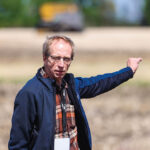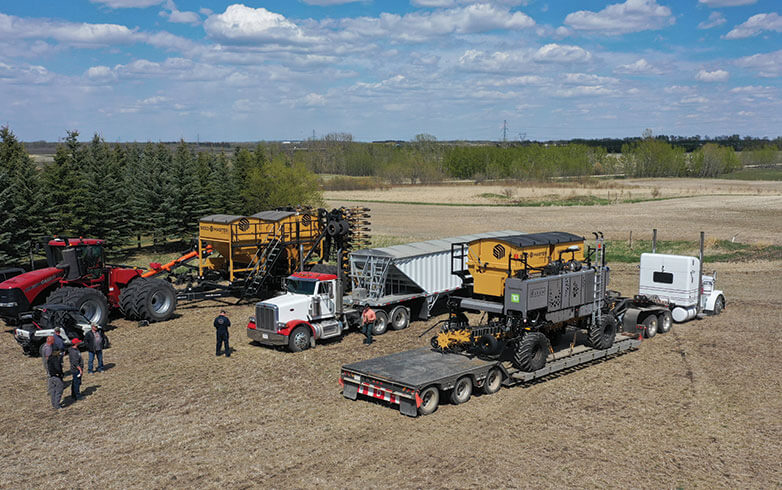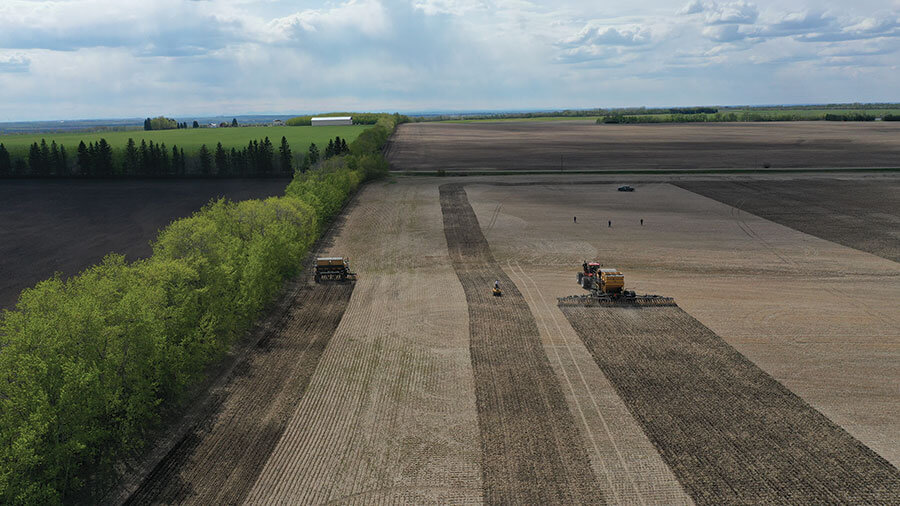Two machines, one person
Chuck Baresich has spread lime with a robot. The farmer and custom applicator from Bothwell, Ontario, southwest of London, experiments with farm robots through his business Haggerty AgRobotics.
“Synchronous operation definitely has a future.”
—Chuck Baresich
“Spreading a bulky product like lime or compost, which can go on at 4,000 lb./ac., is a slow tedious process with one machine,” Baresich says. So he tested a system with two spreaders, one with an operator and one mounted on the autonomous OMNiPower platform. The loader operator also monitored the robot, and both units worked off the same Raven Viper 4 map.
“It’s a pretty cool system,” Baresich says. While it will be difficult to eliminate people from agriculture jobs – from a regulatory and safety perspective – Canadian agriculture could soon commonly see field operations where not all machines have a person onboard.
“Synchronous operation definitely has a future,” Baresich says.
At Olds College of Agriculture & Technology in Alberta, Roy Maki leads a project to test synchronous seeding and spraying operations on Prairie-sized fields. The college has logged 14,000 acres on its OMNiPower unit. “The technology is mature enough that we can run it on broad-acre missions,” Maki says. He uses the word “missions”, which seems appropriate for robots.
For the seeding project, the Olds College OMNiPower unit carries a 30-foot SeedMaster DSR air seeder while the conventional unit is a Case-IH 4WD pulling a 60-foot version of the same seeding tool. Olds College claims this is the first time in agricultural history that one operator controlled two seeders. Field maps were synchronized in real-time, which is essential, using Raven Slingshot technology.
In the first field studied, the autonomous unit seeded 43 of 142 acres, or about 30 per cent.

Maki and his team compared field, fuel and route efficiency for the two units. Field efficiency is the actual time to cover an area relative to the theoretical time it would take the same unit, based on width and speed, to do the job if filling and turning times were eliminated. Field efficiency is 65-70 per cent for both, Maki says. Fuel efficiency is also similar for both. OMNiPower has a slight advantage in route efficiency, which is the shortest possible path to get the job done, because it makes perfect headland turns. “Operator habits and practices may not always be the most route efficient,” Maki says.
Olds College also claims to be the first to try synchronous operation of two sprayers. In the trial, OMNiPower carried a 1,600-gallon tank with 120-foot boom, same as the conventional unit. The productivity difference in the spray trial related to ground speed. The robot worked at 10-12 miles per hour while the conventional sprayer, with more horsepower and operator perception, could travel up to 20 mph.
Perception – the eyes and ears of an operator – is the one major limitation of autonomous units, Maki says. While a human will see a rock pile or a slough and drive around it, OMNiPower, at this time, changes course only if these obstacles are on the prescription map. Otherwise, when it encounters an obstacle, it stops and waits for human help. “When sensing equipment that detects obstacles in real time improves, autonomy improves,” Maki says. “Right now, it needs to have an observer.”
OMNiPower, which began its life as the SeedMaster innovation called DOT, was bought by Raven, which was later bought by CNH. Erin Rinehart, director of strategic marketing with Raven, says OMNiPower is presently being used as a rental and demo platform only. It is not available for commercial sale.
Raven Autonomy has other autonomous platforms, including the Case IH Trident 5550 applicator, which looks like a regular cabbed spreader. OMNiPower is more like an entry-level robot. “Whether it’s at a demo event or hands-on training, the platform serves as an all-encompassing approach to driverless ag as more iron integrated solutions are developed,” Rinehart says. “As we develop more autonomous capabilities, OMNiPower allows us to get more customer feedback – which we use to continuously improve our technology.”

Chuck Baresich at Haggerty AgRobotics is trying various robots, from small weeding robots that drive between rows of wide-row crops to large-size spreaders run synchronously with conventional units.
His vision for synchronous operation has two planters in a field, one autonomous and one regular. The farmer on the regular planter does all the headlands and “goofiness,” while the autonomous planter does the A-B lines. Once the headlands are done, the farmer fills the autonomous unit and lets it finish the field. Meanwhile the farmer packs up and moves to the next field, then has a rest and eats dinner.
“That’s what I see when I think about synchronous operation,” Baresich says.






